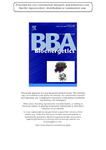Insulin acutely improves mitochondrial function of rat and human skeletal muscle by increasing coupling efficiency of oxidative phosphorylation
| dc.contributor.author | Nisr, RB | |
| dc.contributor.author | Affourtit, C | |
| dc.date.accessioned | 2015-07-09T08:12:20Z | |
| dc.date.available | 2015-07-09T08:12:20Z | |
| dc.date.issued | 2014-02 | |
| dc.identifier.issn | 0005-2728 | |
| dc.identifier.issn | 0006-3002 | |
| dc.identifier.uri | http://hdl.handle.net/10026.1/3418 | |
| dc.description.abstract |
Insulin is essential for the regulation of fuel metabolism and triggers the uptake of glucose by skeletal muscle. The imported glucose is either stored or broken down, as insulin stimulates glycogenesis and ATP synthesis. The mechanism by which ATP production is increased is incompletely understood at present and, generally, relatively little functional information is available on the effect of insulin on mitochondrial function. In this paper we have exploited extracellular flux technology to investigate insulin effects on the bioenergetics of rat (L6) and human skeletal muscle myoblasts and myotubes. We demonstrate that a 20-min insulin exposure significantly increases (i) the cell respiratory control ratio, (ii) the coupling efficiency of oxidative phosphorylation, and (iii) the glucose sensitivity of anaerobic glycolysis. The improvement of mitochondrial function is explained by an insulin-induced immediate decrease of mitochondrial proton leak. Palmitate exposure annuls the beneficial mitochondrial effects of insulin. Our data improve the mechanistic understanding of insulin-stimulated ATP synthesis, and reveal a hitherto undisclosed insulin sensitivity of cellular bioenergetics that suggests a novel way of detecting insulin responsiveness of cells. | |
| dc.format.extent | 270-276 | |
| dc.format.medium | Print-Electronic | |
| dc.language | en | |
| dc.language.iso | eng | |
| dc.publisher | Elsevier BV | |
| dc.subject | Skeletal muscle cells | |
| dc.subject | Insulin sensitivity | |
| dc.subject | Oxidative phosphorylation | |
| dc.subject | Mitochondrial coupling efficiency | |
| dc.subject | Cell respiratory control | |
| dc.subject | Mitochondrial proton leak | |
| dc.title | Insulin acutely improves mitochondrial function of rat and human skeletal muscle by increasing coupling efficiency of oxidative phosphorylation | |
| dc.type | journal-article | |
| dc.type | Article | |
| plymouth.author-url | https://www.ncbi.nlm.nih.gov/pubmed/24212054 | |
| plymouth.issue | 2 | |
| plymouth.volume | 1837 | |
| plymouth.publication-status | Published | |
| plymouth.journal | Biochimica et Biophysica Acta (BBA) - Bioenergetics | |
| dc.identifier.doi | 10.1016/j.bbabio.2013.10.012 | |
| plymouth.organisational-group | /Plymouth | |
| plymouth.organisational-group | /Plymouth/Faculty of Health | |
| plymouth.organisational-group | /Plymouth/Faculty of Health/School of Biomedical Sciences | |
| plymouth.organisational-group | /Plymouth/REF 2021 Researchers by UoA | |
| plymouth.organisational-group | /Plymouth/REF 2021 Researchers by UoA/UoA01 Clinical Medicine | |
| plymouth.organisational-group | /Plymouth/Research Groups | |
| plymouth.organisational-group | /Plymouth/Research Groups/Institute of Translational and Stratified Medicine (ITSMED) | |
| plymouth.organisational-group | /Plymouth/Research Groups/Institute of Translational and Stratified Medicine (ITSMED)/CBR | |
| plymouth.organisational-group | /Plymouth/Users by role | |
| plymouth.organisational-group | /Plymouth/Users by role/Academics | |
| dc.publisher.place | Netherlands | |
| dcterms.dateAccepted | 2013-10-29 | |
| dc.identifier.eissn | 0006-3002 | |
| dc.rights.embargoperiod | No embargo | |
| rioxxterms.versionofrecord | 10.1016/j.bbabio.2013.10.012 | |
| rioxxterms.licenseref.uri | http://www.rioxx.net/licenses/all-rights-reserved | |
| rioxxterms.licenseref.startdate | 2014-02 | |
| rioxxterms.type | Journal Article/Review | |
| plymouth.funder | Why do pancreatic beta cells waste energy?::MRC |


